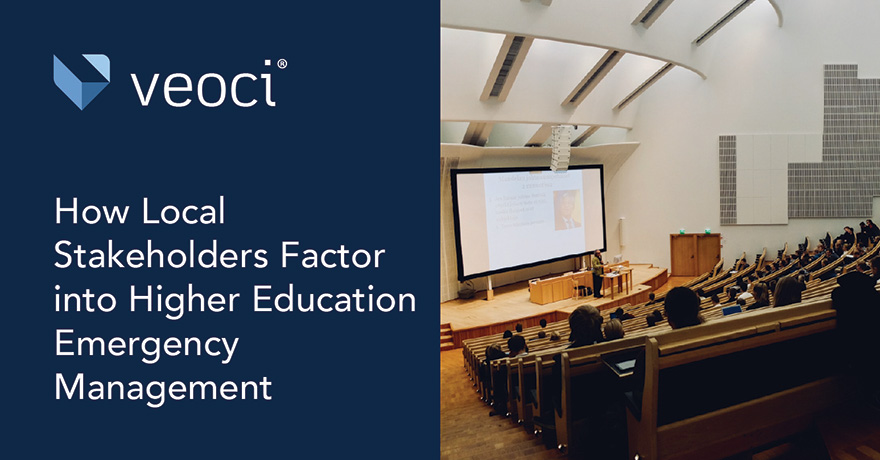This blog was updated on August 4th, 2025.
Colleges and universities are more than campuses—they’re active hubs within their local communities. From game days to emergencies, these institutions regularly impact and rely on nearby city agencies, healthcare systems, and public safety departments. Coordinating with local stakeholders isn’t optional; it’s essential for keeping campus and community safe, informed, and prepared.
Making Connections: Local Stakeholders
Higher education institutions are deeply woven into their local communities. Emergency managers must stay aligned with county, city, and state-level agencies, especially during incidents that cross jurisdictional lines. When emergencies hit, coordination with local schools and first responders becomes critical—and clarity can be challenging.
Game days, for example, call for collaboration with city police, fire departments, and healthcare systems. Veoci’s Game Day solution helps teams share real-time updates and manage logistics in one central place. To see how this works in action, check out our University of Alabama Webinar.
Campus EOCs often lack certain resources, where community partnerships fill the gap. But overlapping leadership can cause friction. Digital tools like Veoci bring structure to complex emergencies, ensuring clear authority and streamlined operations.
Prior Knowledge: Special Events
Special events like commencements and concerts can strain resources and relationships if communication isn’t planned ahead. Emergency managers should inform local authorities early, especially for high-impact days that increase foot traffic and visitor volume.
Game days add another layer—campus police, EMS, local hospitals, and stadium staff must be fully aligned. Veoci’s Game Day solution ensures that check-ins, incident reports, and task tracking happen in real time.
Before digital tools, each stakeholder sat in a physical EOC at the table. Now, dispersed teams rely on virtual coordination, making a unified platform more critical than ever.
Making the Move to a Platform
A digital platform ensures everyone—from campus EMS to city fire crews—is connected. Real-time updates, task assignments, and plan activations keep chaos in check. If an incident occurs on game day, medical personnel can alert hospitals instantly, triggering faster care and response.
Veoci offers dashboards and workflows that enhance coordination. Resource requests become structured, roles are defined in advance, and nothing falls through the cracks. With more stakeholders participating virtually, centralized platforms boost awareness and response times.
Virtual platforms also power joint drills and tabletop exercises. Whether led by the university or in partnership with local agencies, these simulations strengthen preparedness and build relationships. The trust earned in practice often becomes invaluable in the real world.
Building Trust, Ensuring Readiness
As emergencies and large-scale events grow in complexity, the divide between campus and community continues to shrink. Colleges and universities must take a proactive role in fostering collaboration with their local stakeholders—not just during crises but also in the planning stages and daily operations. When everyone is connected through a unified digital platform, trust is built, responsibilities are clarified, and responses become more effective.
Solutions like Veoci empower institutions to coordinate seamlessly, act swiftly, and reduce confusion when it matters most. Whether it’s a game day, natural disaster, or unexpected campus incident, the groundwork of partnership and preparedness ensures that the campus and surrounding community can respond together, stronger and more resilient than ever.








